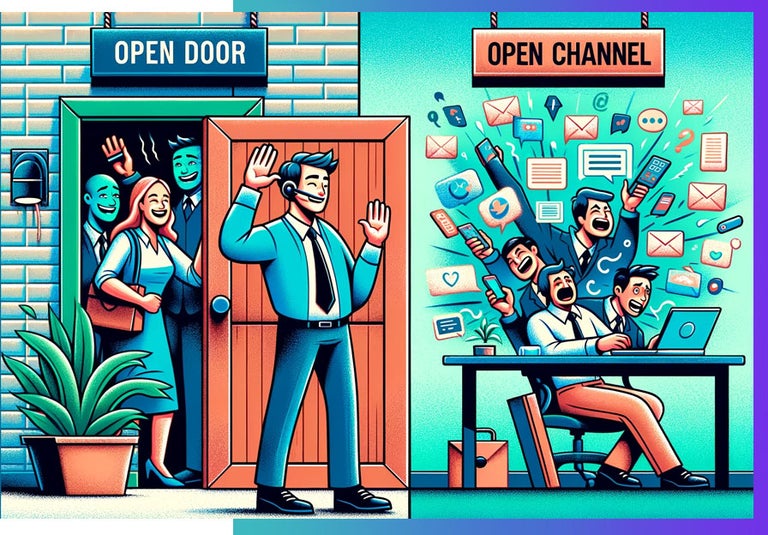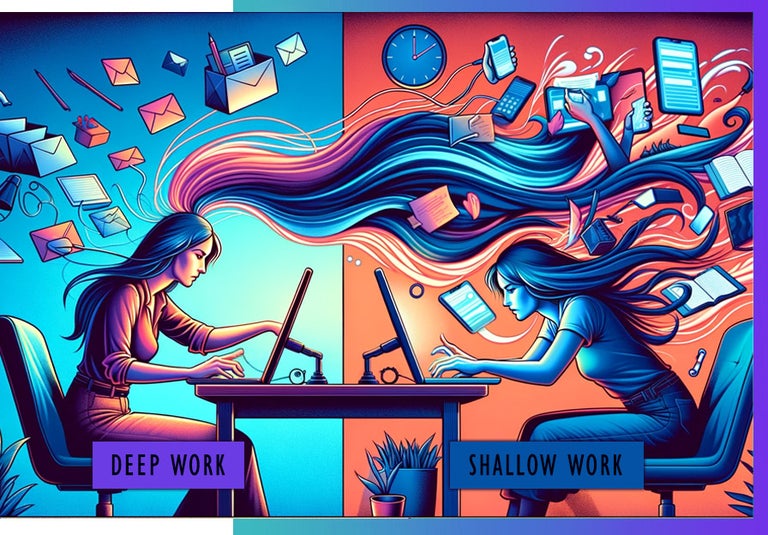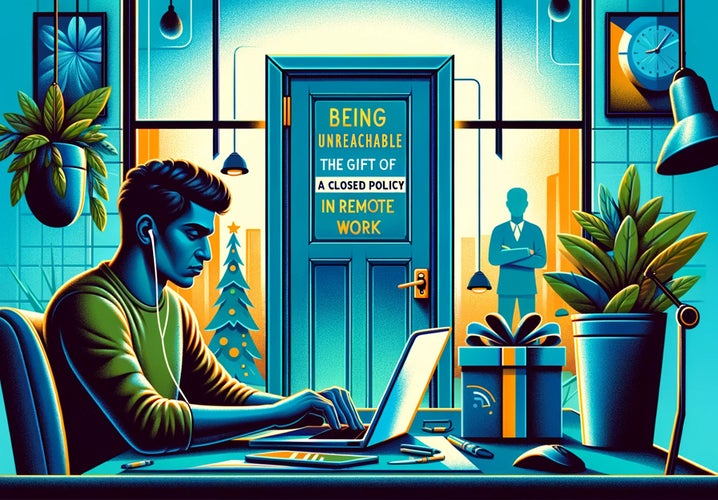Contents
- The Problem with The Open Door Policy in Remote Work
- Deep Work vs Shallow Work: The Impact
- The Solution: Your Closed Door Policy
- Switching Sides: From Open to Closed in 2024
For remote leaders, a closed-door policy is a gift that keeps on giving. This holiday season, it’s time to throw away the old advice that no longer serves you, to make room for an additional helping of deep, not shallow, work.
Deck the halls with these new rules for achieving remote leadership nirvana.
What if I told you that you need to become unreachable?
It’s not advice you hear very often. In fact, there are hundreds of business books tearing the idea apart.
In a traditional office environment, being unavailable to your team is a sign of a bad manager. But what happens when you lead a global team who works remotely?
A recent study found that remote leaders need autonomy to be highly productive. In contrast, collaborating too much in a remote work environment can lead to decision fatigue and decreased creativity due to digital burnout.
So here we are trying to force collaboration-first management on leaders who need more autonomy.
In this article I’m going to unwrap why every remote team leader should consider switching from an open-door policy to a closed-door policy in 2024.
Stay with me on this one and you’ll discover that the impact is astounding.
The Problem with The Open Door Policy in Remote Work
No time is busier for a remote team than the festive season.
People are finishing up a year’s worth of work, final reports are in progress, and key people are taking time off over the holidays.
For a remote manager with an open-door policy this can be disastrous.
And that’s because the primary driver of productivity is not ‘transparent collaboration’ like it is at the office. Whatever pros an open-door policy offers traditional managers, can quickly flip for someone leading remotely. There’s a really simple reason for this!
In remote work, the primary driver isn’t collaboration, it’s autonomy.

The Open Door
An open-door policy can be great for traditional managers.
Employees know that at any time they can knock on the door and ask questions, request feedback, or get some guidance on what to do next.
But because of physical limitations and proximity to other colleagues, managers are generally left alone.
The hierarchical nature of the office lends itself to collaborative in-person problem-solving.
The Open Channel
What happens when those doors are instant messages, quick emails, multiple forms of video chat and Slack channels?
Taking the open-door policy and applying it to remote work is the same as emptying out the office and adding dozens of doors straight to a single manager.
With no physical limitations and an abundance of ways to contact a manager – any person would – on average – send more messages.
Now multiply that across a global team that can be any size, and add courage because you no longer have to see your manager in person.
Information overload is real.
Look at this:

What works well for traditional managers is seriously problematic for remote managers.
Tsedal Neeley from Harvard Business School, author of ‘Remote Work Revolution’ has questioned the wisdom of open-door policies, saying that they are counterproductive for remote teams, adding stress and decreasing productivity. And we agree.
Open door policies can become extremely toxic for remote managers who need to focus on deep work. Cal Newport defines it as ‘the ability to focus without distraction on a cognitively demanding task.’ In tech, that’s the majority of critical work done.
Deep Work vs Shallow Work: The Impact
Remote leaders who try to embrace an open-door policy are plummeted into a state of constant harassment and channel communication overload.
This actively destroys their ability to perform deep work. And without deep work, tasks that require higher cognitive capacity will suffer, slow down or grind to a halt.

It’s the skill that allows people to focus on a challenging task for extended periods of time without getting distracted. Fans of deep work talk about ‘flow’ or being in a flow state.
That’s when you’re so deeply focused on a single task, you’re highly innovative, creative, engaged and productive.
HBR says it can increase productivity by 500%.
Things get done! It’s the holy grail of productivity for remote teams.
Deep work is also the opposite of shallow work.
Compulsive multitasking, admin work, answering messages – the kind of stuff that doesn’t require much focus or neurological function to perform.
If you are constantly distracted (like many remote leaders are) then you are operating in a permanent state of shallow work.
Think of deep work as the main character, the driving force behind action and results. Shallow work on the other hand, is the extra in the background who has to be there, but just looks busy all the time.
A remote manager who is stuck in shallow mode will not be an effective leader.
· 99% of people check their emails daily, up to 20X a day
· The average person spends 145 minutes a day on social media
· Those who use Slack use it actively for 90 minutes day
There is a massive cost to spending your day stuck in shallow work. Cal Newport says that if you do this regularly you can permanently reduce your capacity for concentration.
And as you know by now, focus is a modern-day superpower.
Use it or lose it.
The Solution: Your Closed Door Policy
Here’s the revolutionary solution: switch your open-door policy for a closed door policy at work - wherever that might be.
I don’t mean become completely unreachable and unavailable to your team.
I mean become intentionally available and reachable during set times. The majority of your day should still be dedicated to deep work – and the pursuit of helping your remote team achieve it too.
Chase Warrington speaks about it in a video interview he filmed with Andrew this week. His solution was to improve his centralized company documentation to encourage greater autonomy.
This is part of an ongoing closed-door policy that will keep his global team working asynchronously and without constant interruption. It’s an exceptional strategy for async work.
Before switching to your closed-door policy, ask yourself: “What are the gate openers for a successful closed-door policy?”
It’s important not to read ‘closed-door’ as ‘never reachable.’ The last thing you want to do is block other team members from making progress. The goal is always to enhance productivity, not cripple it.
While it’s tempting to slam the door and be done with it, interdependence is about:
1) Knowing when to reach out and to who
2) Knowing when to go deep to get things done
Here’s a checklist to make sure that you’re on track before the switch.
- Clearly written, living documentation accessible by everyone
- A central platform where resources are provided to facilitate problem-solving
- Set quality bars and encourage team members to improve on them
- Set expectations around response times and availability windows
- Clarify the rules of empowerment…
- What decisions can team members make autonomously?
- What should trigger escalation?
- What should happen in an emergency?
- Use imperfect choices as coaching opportunities and never cast blame if the process was followed
- Touch base in a virtual meeting on what does and doesn’t work with the process
Here are 5 pro tips for your closed-door policy:
- Earmark hours for contact and defend focus time (Use smart scheduling tools like Reclaim.ai)
- Relentlessly reduce distractions (think tool reduction and centralization)
- Introduce environmental training (how to create a workspace for deep focus)
- Avoid context switching (switching from one unrelated task to another)
- Drain your shallows (Newport uses this term as a way to prioritize your daily shallow work)
Switching Sides: From Open to Closed in 2024

Studies have shown that autonomy is the key to productivity in remote environments. Not collaboration. Are you creating a global team of shallow workers?
· Every 15 minutes a remote worker’s focus is interrupted
This isn't about shutting out your team - it's about opening the door to deep, meaningful work. So, forget the old notion that availability equals productivity.
That’s a great way to burnout from communication overload!
In the global remote space, autonomy reigns supreme. Make the move now. Set specific hours for communication, cut down on the digital noise, and champion focused workspaces.
As you implement this closed-door approach, watch as your remote team's productivity soars, creativity blooms, and problem-solving sharpens.
The impact on your own work will be definitively measurable.
You're not just closing a door, you're opening a gateway to heightened focus and that much-desired flow state. This festive season, give your team the gift of deep work by becoming unreachable.
Step into 2024 as a remote leader who's not just ‘available’ but focused on making an impact.
And remember, sometimes you have to close a door to keep out the noise.
Happy holidays!








